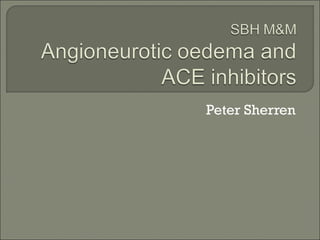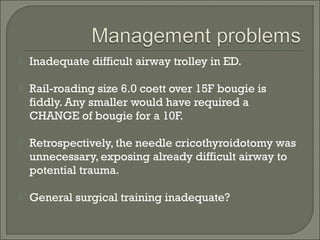Angioedema
- 2. NOT EVERY SWOLLEN FACE IS ANAPHYLAXIS
- 3. ï In 1990, the Association of Anaesthetists of Great Britain and Ireland (AAGBI) published its first report on suspected anaphylactic reactions associated with anaesthesia. ï The reported suspected that, between 1995-2001, anaphylactic reactions related to anaesthesia in the UK averaged 55 per year, compared with 319 for all drugs1. ï 10% of anaesthetic reports were of fatalities compared with 3.7% for all drugs reported1. ï The understandable concentration on anaphylaxis within anaesthesia means that the knowledge of differential diagnoses and therapeutic options may be limited.
- 4. ï 66 yr-old Afro-Caribbean lady ï MP V? ï Htn, DM, IHD and PPM ï 05.00 Sudden onset tongue swelling and DIB ï Called to DGH ED 06.15 ï Dramatic angioedema+, drooling++, stridor, poor vocalisation, agitated, SpO2 ~92% FiO2 0.85 FM. CVS stable
- 5. ï Unexpected complication of treatment. ï Unresponsive to steroids/anti-histamines/adrenaline. ï ODP transported difficult airway trolley to resus. ï Surgical Spr not happy/competent to perform emergency awake trache. ï 18g cannula cricothyroidotomy performed pre-induction uneventfully. ï RSI, Grade III/IV (oedematous, distorted anatomy) view with McCoy. ï GEB sited 3rd pass. ï Unable to pass 7.0 coett, 6.0 passed with difficulty, minimal leak with no cuff deflated. ï No issues ventilating. ï Progression of angioedema post intubation. ï 10 day ICU admission, discharged to ward neurologically intact with trache insitu.
- 6. ï Out of hours communication/mobilisation of staff and equipment outside of theatres. ï Familiarity with, and applied use of equipment on a well-stocked (theatre) difficult airway trolley. ï Flexible use of DAS algorithm.
- 7. ï Inadequate difficult airway trolley in ED. ï Rail-roading size 6.0 coett over 15F bougie is fiddly. Any smaller would have required a CHANGE of bougie for a 10F. ï Retrospectively, the needle cricothyroidotomy was unnecessary, exposing already difficult airway to potential trauma. ï General surgical training inadequate?
- 8. ï Causes of angioneurotic oedema ï Idiopathic- large proportion. ï Mast cell related/anaphylaxis. ï Hereditory (HAE) I and II- C1 inhibitor deficiency or dysfunction. ï Acquired- immunosuppression and lymphoproliferative disorders. ï Drug related- Aspirin/NSAIDS, ACE, opiates, abx. ï ACE inhibitors related angioneurotic oedema2,3: ï Now most common exogenous cause of angioedema seen. ï Can occur any time from initiation through to 10 years into treatment. ï 0.1-0.5% of those receiving the drug. ï Usually has no associated urticaria. ï Due to increased bradykinin levels because kinin degradation is inhibited. ï Can cause dramatic swelling of tongue, pharynx, or larynx- Secure airway early. ï Deaths related to AIRWAY, no reported deaths from primary CVS collapse. ï Some response to Adrenaline and minimal to steroids and anti-histamines.
- 10. ï In angioneurotic oedema (like burns): âĒ Use of size 10F bougie âĒ Use of uncut COETT âĒ Range of sizes of COETT ready for use ï Potential unique use of the Melker vs other large bore cricothyroidotomy kit ï Improvement/standardisation of difficult airway trolley in ED
- 11. ï Choice of large bore cricothyroidotomy kit? âĒ CUFFED seldinger vs PCK vs Quicktrach II ï Place for selected pre-emptive cannula cricothyroidotomy and later use of Melker?
- 12. 1. AAGBI Working party. SUSPECTED ANAPHYLACTIC REACTIONS ASSOCIATED WITH ANAESTHESIA. AAGBI Revised Edition 2003. www.aagbi.org 2. Adebayo PB, Alebiosu OC. ACE-I induced angioedema: a case report and review of literature. Cases J. 2009 Jul 27;2:7181. 3. Cupido C, Rayner B. Life-threatening angio-oedema and death associated with the ACE inhibitor enalapril. S Afr Med J. 2007 Apr;97(4):244-5
Editor's Notes
- #9: HAE-Chromosome 11 deletion, use of FFP and C1 inhibitor concentrate Vs standard treatment Steroids/antihistamines/adrenaline











